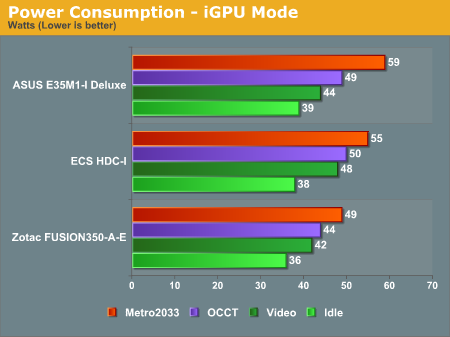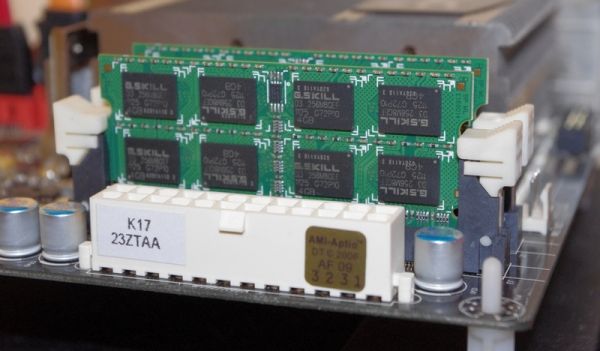Fusion E-350 Review: ASUS E35M1-I Deluxe, ECS HDC-I and Zotac FUSION350-A-E
by Ian Cutress on July 14, 2011 11:00 AM ESTTest Setup
| Processor |
AMD Fusion E-350 2 Cores, 2 Threads, 1.6 GHz |
| Motherboards |
ASUS E35M1-I Deluxe ECS HDC-I Zotac FUSION350-A-E |
| Cooling | Onboard |
| Power Supply | Silverstone 80 PLUS Silver |
| Memory |
G.Skill Sniper DDR3-1600 9-9-9-24 2x4GB Kit, 1.25V G.Skill SODIMM DDR3-1066 9-9-9-24 2x4GB Kit 1.5V |
| Memory Settings | Auto |
| Video Cards |
XFX HD 5850 1GB ECS GTX 580 1536MB |
| Video Drivers |
Catalyst 10.12 NVIDIA Drivers 275.33 |
| Hard Drive | Micron RealSSD C300 256GB |
| Optical Drive | LG GH22NS50 |
| Case | Open Test Bed - CoolerMaster Lab V1.0 |
| Operating System | Windows 7 64-bit |
| SATA Testing | Micron RealSSD C300 256GB |
| USB 2/3 Testing | Patriot 64GB SuperSonic USB 3.0 |
Many thanks to...
G.Skill have happily provided us with a set of their low voltage, gamer oriented, Sniper series DDR3 memory for this a future reviews, where low power usage may be of interest to the consumer. This 2x4 GB kit (D3-12800CL9D-8GBSR2) runs at 1600 MHz speeds with 9-9-9-24 2N timings at 1.25 V, and is currently available for $90.
What's actually interesting for me is to see how the power consumption readings change when going from normal 1.5 V memory, to the low voltage 1.25 V stuff. Technically we should see a power drop, but after playing around with the ASUS board in this review and the memory, the most I could predict (with general power levels fluctuating +/- 1 W as you would expect) is 1-2W maximum saving, if any at all. Over a year, it's true it's not that much power, and in a 60W system we're only talking 1% - it's more of a tool to say that people are being energy conscious (in my view).
G.Skill have also supplied us with a set of DDR3-1066 C9 SO-DIMM for the Zotac board review. This 2x4GB kit (F3-10666CL9D-8GBSQ) runs at 1066 Mhz with 9-9-9-24 timings at 1.5 V, and is currently available for $63.
Comparison to Previous Results
Where applicable, the results in this review are directly compared to the following chipsets and boards which we have reviewed previously:
Power Consumption

The Zotac scores best across the board in terms of power consumption.
(Note: I was using a less than ideal power supply for the power draw tests which was very inefficient in this range (<20% of maximum power), and unfortunately I don't have anything more appropriate at hand to test with. The comparisons (I believe) between the boards are more than relevant though. I will hopefully rectify this in future reviews of lower powered systems.)
CPU Temperatures

Given that both the Zotac and the ASUS boards are passive, you would expect their temperatures across the board to be higher than that of the ECS. However, the ECS has a small heatsink, meaning at idle the CPU is actually quite warm, and the fan spins up according to the temperature. Given a flat 45 Celsius from the ECS, I redid the tests by cooling the heatsink with other fans, removing them, and letting it warm up at idle, and ended with the same result. Overall, the Zotac performs the best out of these three.












67 Comments
View All Comments
mschira - Friday, July 15, 2011 - link
I find it hard to believe how calmly the praises for the 33% overclock are. Just face it the Lano platform can use all the speed it can get, and that 33% sounds healthy enough.At 1.6 I think Lano is slightly underpowered, at 2.1Ghz, well slightly less i.e. not anymore.
It hard to understand why AMD isn't coming up with a 2Ghz variant of Lano. I fact I find it very concerning. It looks as if AMD is just not determined enough to compete with Intel.
M.
Rick83 - Friday, July 15, 2011 - link
E350 is not Llano.And mini ITX E350 is not meant for overclocking and performance.
Thus I find this to be a bit of a non-feature. Better to get a passively cooled 32nm Intel S1156 Pentium, if you need more performance.
As far as I know, the only drawback this level of performance has, is when flash movies at extreme settings are played. While this may be important for some, it's not needed in a general browsing/mail machine that does the odd office application. Nor in most home cinemas, where local mkvs or disks are played.
Yet for this overclock you give up on passive cooling and instead get a tiny, and presumably relatively whiny fan. Not worth the hassle.
AmdInside - Friday, July 15, 2011 - link
I have an older ITX case I would like to continue using and it puzzles me why almost all of these mobos use a 24-pin connector when there are so many ITX cases with a 20-pin connector.andymcca - Friday, July 15, 2011 - link
Does anyone spend money on WHS for NAS? Seems like a waste. (Don't get me wrong, I see some reasons to get it if text scares you and you are doing something more complicated. And have money to burn. Or live on a pirate ship.)RAID is supported in the Linux kernel, and is better than any junky fakeRAID a motherboard might provide. And with 6 SATA 6Gb/s ports, this makes a damn fine NAS!
andymcca - Friday, July 15, 2011 - link
Though the lack of 1000 Gb/s ethernet is sad :(andymcca - Friday, July 15, 2011 - link
I'd settle for 1Gb/s :)Rick83 - Friday, July 15, 2011 - link
which all of these boards have.burpnrun - Friday, July 15, 2011 - link
Firstly, the author starts by positioning the AMD CPU/boards in a HTPC context. Then promply forgets any consideration of a HTPC role. Not one video/encoding/decoding/transcoding benchmark. Instead, "games" and "computational" benchmarks. WTF? I'm wondering, is this guy competent?Secondly, as other posters have commented, the author's/article's power consumption measurements are so outlandish as to be laughed at. I mean, seriously warped versus reality. Incompetence (and determined reluctance to remeasure/fix) is brashly showing through at this point.
The coup-de-gace of this idiotic review, though, is the inclusion of a Nvidia 580GTX for games, a role the Brazos CPU/Chipsets are not positioned towards. A 580GTX? In a 4x PCIe slot? And there are problems? WOW. I wonder why? At this point I concluded that not only was the author totally incompetent, but the motive of the article was also highly suspect.
Until Arnand cleans up this stinking pile of pseudo "review", I'm not coming back here. I'm not a Intel or AMD fanboy, but this is such an incompetent, biased, purposeless (or was there a mission here that tried to be masked by "review" status?) article that a line has to be drawn in the sand against outright c*rap "reviews" like this.
Anand, you should be ashamed to even have this piece of junk on your site!
ET - Friday, July 15, 2011 - link
If this is the worst review you've read in 15 years, uou must not read a lot of reviews, so your threat of not coming back probably means that the next review you'll read in five years will be on another site. If you really want, I can point you to a lot of other sites with worse reviews.Not saying that this review is perfect, but come on, lots of other reviews of the E-350 have done exactly the same things, and some of your issues are nit-picking. Would you had been happier if a lower end discrete card was put in the PCIe slot? Putting a very high end one just illustrates how CPU bound this platform is.
AnandThenMan - Friday, July 15, 2011 - link
"lots of other reviews of the E-350 have done exactly the same things"Post the links, I'd like to read them. Thanks.